To tell the truth, I’ve stolen the expression DELUXE from someone else. I stumbled over the idea that the MFB Dominion 1 synthesizer should actually be called “Dominion Deluxe” while reading a short description on the Schneiders Laden website. And Andreas Schneider kindly gave me permission to spread this idea among our faithful readers. So the new MFB offspring will now be called DELUXE – a noble attribute it well deserves.
How did MFB come to build such an impressive synth? Let’s turn the clock back a few years. 35 years, to be exact. In 1979 Manfred Fricke began producing synthesizers, sequencers and drum computers, which is to say he began building electronic music instruments. His small company in Berlin has since brought out many interesting products, notwidthstanding the trials and tribulations of time. Dominion 1 appeared on the market in the summer of 2014, after an imposing 3 years of development by Manfred Fricke and Uwe George Giegler (aka yapacc).
Our earlier report on the MFB Dominion X / X SED – the OSCar effect included an in-depth discussion of the Dominion desktop version. Many of the nice little details discussed there are still relevant, of course, but the keyboard version has some new little niceties as well.
Our songs of praise for the Dominion 1 should be underscored, considering the scanty range of new analog synthesizers on the market today. Yamaha and Roland don’t feel any necessity there and have no analog synths in their program. Korg does go along with the fun, but their analog groove instruments (Volca Series) are rather small, aside from those diverse MS-20 clones. So, let’s cast a glance not at the BIGGIES, but at the LITTLE ones.
Moog is still clinging to the successor-of-the-successor-of-the-successor-of-the-Minimoog concept. Voyager, Little Phatty, Sub XY – … for those of you who still don’t have a synth with a cascade filter: you can choose amongst the many! Tom Oberheim’s SEM modules are well know and reliable. And Dave Smith has remained loyal to his Prophet-line – Prophet-12, Pro-2: old classics in new cloths – at least according to their name (the technical part, of course, is brandnew and up to date). Arturia’s hardware synth-debut with MiniBrute and MicroBrute is a promising start on the analog side of things.
So the world market is more or less flooded with new analog synths based on the names of old classics (but without the instrument’s original sound quality), with a few exceptions here and there. However, innovation is something else, more a domain of the modular/Eurorack field (Endorphin.es, Make Noise, Cwejman, Doepfer, Verbos …) and of the stand-alone synth-area (MacBeth Elements, Dreadbox Murmux, Vermona PERfourMER MKII, Elektron Analog Four …). Be that as it be …
MFB’s Dominion 1 is in many ways just the ticket. This analog synth (3-octave- keyboard, MIDI, CV-patch field) with its vast sound architecture and its many controllers is the product of an unusual concept. Dominion 1 is one of those rare instruments that completely covers studio analog sound-and-performance requirements. Add a polyphonic synth, a drum computer and a notebook (for recording) and you’re all set! Nothing else is needed – the Dominion 1 fullfills your every wish. That’s its job.
[Ok, ok … the new Arturia MatrixBrute surpasses the Dominion 1 in many ways. But while Arturia synthesizers (generally) sound a little clinical and straight, the Dominion 1 offers an amazingly warm – deeply analog – sound.]
The hardware
The Dominion 1 is suprisingly heavy. A well-built metal case, solid wooden panels – no complaints there. It’s great that it has an integrated power supply (not to be taken for granted these days). The big knobs are comfortable to use (don’t worry – we’ll get to some criticism later). Those white (or black) dots watching you from the buttons are lovely remeniscences of the vintage RSF Kobol synth. The various color combinations allow for a quick overall survey of the sound architecture.
Whereby dreams are allowed. To be honest, the “ideal” Dominion 1 would be somewhat larger. The closely positioned knobs have resulted in miniscule printing. A little hard to read, a little hard to adjust. Font size 8, we would estimate. And that is not very large. Affording good lighting and exacting glances, if you want to keep everything under control.
Which is to say a larger Dominion 1 would allow not only for more room between the knobs, but also for larger font size (8.5 – smile). Not to mention that there would be room for a 3,5- or 4-octave keyboard, along with an extra pitch bender / mod wheel unit in addition to the existing ribbon controllers. That would be luxury pure.
Be that as it be, the Dominion 1 knobs are very good. You can get a good grip on them, they are large and stable. We can’t say the same for the faders. They are one of the very few weak points of the instrument. They sort of sprawl and wiggle. Which is just a little dent in the excellent impression Dominion 1 has made on us. Something we can live with. And something you can certainly make excellent music with.
And then there are those little black switches – for selecting sounds (a grand total of 128 can be saved!), and for various system functions. They do a good job. The two ribbon controllers are of high quality and the cv-panel jacks are well-attached to the chassis. So, aside from the faders, the overall hardware quality is on a high level.
A small but very remarkable new aspect deserves to be mentioned here. The printing on the back appears doubled: normal and upside down. Which is something you also find by the diverse Manikin- and Jomox-instruments (shall we call this a Berlin nicety?). Very useful when changing MIDI connections, for example. Slightly upending the instrument gives you a full view of the rear side connections.
The concept
Before taking the individual parts of the Dominion 1 into consideration, let’s take a quick look at the overall concept of the instrument.
It didn’t take long for the Dominion 1 to gain its reputation as the epitome of monophonic analog synthesizers with keyboard, MIDI and CV/Gate. That is to say the epitome of monophonic analog synthesizers with keyboard, MIDI and CV/Gate along with all its inherent creative possibilities. To say it in a nutshell, the perfect (monophonic) analog synth many musicians have been looking for.
As far as hardware design is concerned, we would certainly welcome an expanded version of the Dominion 1 (more distinct lettering, better faders and an extended keyboard). But wishful thinking aside, what are we really looking for? There is nothing spectacular missing on the Dominion 1. It has everything. And it can do everything. All modulations, all thinkable connection possibilities, all kinds of filters, lots of controllers … its concept is nearly perfect.
Taking it from there, let’s look at the Dominion 1 in detail …
3 versatile VCOs
The 3 VCOs are – more ore less – identical:
- VCO1: triangle, sawtooth, pulse, analog ring modulator
- VCO2: triangle, sawtooth, pulse, digital ring modulator
- VCO3: triangle, sawtooth, pulse, digital ring modulator
Oscillator tuning possibilities are superb. The six-stage octave selector ranges from 32’ to 1’. In addition, there’s a regular (fine) tune knob. VCO1 tuning sets the general tuning for all three oscillators (and thus for the whole instrument), the range is approx. ±6 semi tones. Tune control for VCO2 and VCO3 range approx. ±13 semi tones, allowing detuning by a little more than an extra full octave. So, all in all VCO2 and VCO3 have a tonal range of more than 7 octaves …
Various aspects of each VCO can be modulated:
- Level – pre-mixer level modulation by LFO1
- Pitch1 – pitch modulation by LFO1 (up to ± 2 octaves)
- Pitch2 – pitch modulation by LFO2 (up to ± 2 octaves)
- ADSR1– pitch modulation by envelope ADSR1
- PWM – modulation of waveform symmetry by LFO1
- PW – manual modulation of waveform symmetry by Modulation control
LEVEL modulation is a very handy feature, allowing to fade-in and fade-out single oscillators. PITCH modulation is a very powerful feature, since the modulation sources are wide-range LFOs (LFO1 and LFO2, going – in key-track mode – up to 1,2 kHz). PWM and PW are very unusual features, since they can affect the symmetry of all VCO waveforms (… this is not only pulse-width-modulation, but also triangle-width- and sawtooth-width-modulation, to be exact).
And then there is a separate oscillator FM section:
- VCO1 – is modulated by VCO3
- VCO2 – is modulated by VCO3
- VCO1+2 – are both modulated by VCO3
The amount of frequency modulation can be set manually or dynamically using one of the following sources:
- LFO1
- LFO2
- ADSR1
- ADSR2
- AD
Ah yes … instead of VCO3 you may use an external signal (fed into the FM In jack) for oscillator FM. And last but not least there is the patchbay, containing CV-INs and CV-OUTs for all VCOs. Not bad, hm …?
Unique VCF with 12 modes
The Dominion 1 multimode filter is quite unique in synth history. (Ok, there’s the Oberheim Xpander / Matrix-12 multimode filter with 15 different modes … but other than that …). All modes are based upon the SED circuit (Single-Ended & Discrete).
Use “Filter Select” to choose between these FILTER MODES:
- LP1 – 24 dB LowPass
- LP2 – 18 dB LowPass
- LP3 – 12 dB LowPass
- LP4 – 6 dB LowPass
- BP1 – BandPass with 18 dB LowPass and 6 dB HighPass
- BP2 – BandPass with 12 dB LowPass and 12 dB HighPass
- BP3 – BandPass with 6 dB LowPass and 6 dB HighPass
- BP4 – BandPass with 6 dB LowPass and 12 dB HighPass
- NO1 – BandPass with 6 dB LowPass and 6 dB HighPass
- NO2 – Notch combining 6 dB LowPass and 6 dB HighPass and additional 6 dB LowPass
- HP1 – 6 dB HighPass
- HP2 – 12 dB HighPass
One might suspect that this is a little exaggerated. “Ok, where is the difference between LP2 and LP4?” True – the difference between this and that filter sometimes seems to be not “that” big. BUT … think it over and you’ll figure out that there’s a correlation between filter resonance, filter frequency and the effectiveness of certain filter types. BandPass and HighPass show their true faces at HIGH resonance settings and LOW filter frequency. Fiddle around and you’re in for the one or other eye-opening experience …
In sum, the tonal potential of the Dominion 1 filter is enormous. The strong / dominant LowPass filters and the creamy Notch filters produce real delicacies. But what can you say? BandPass and HighPass are sometimes even more powerful (remember the filter-resonance-thing?), with a wide range of beautiful tone colors. Just listen to the 40 minutes of audio files attached.
This filter is one of the finest in synth history. As we say: it is DELUXE!
You might have discovered in the above graphic that filter resonance modulation is possible, too. Quite a rare feature, really. Hm … ok, ok … regarding music performance, resonance modulation is not always that efficient. (No wonder that it is just not that common.) BUT … let’s go back once more to the correlation between filter resonance, filter frequency and the effectiveness of certain filter types (especially BandPass and HighPass). The sheer power of those filters comes into its own at higher resonance settings, so – we’re closing the circle – resonance modulation IS quite a handsome feature.
But there’s more! The filter may be modulated from innumerable sides. Have a close look at the following chart …
Dominion 1 offers the following areas for filter modulation (all available simultaneously, of course):
- VCF MOD (to be found directly in the filter section, with various modulation sources)
- Ribbon 1 and Ribbon 2
- Aftertouch and Velocity
- ADSR1 (and also ADSR2 and AR via patchbay)
- Filter CV-IN
- Sequencer
- MIDI
Still missing something? I’d say “no”!
Envelopes and LFOs
Well, Euphoria, just cool down a little bit. The envelopes are good, but not fantastic. They are software-based (now we have the villain!). Software is not necessarily a bad thing per se, but the chip inside Dominion 1 is not that powerful. To be clear: the envelopes are a bit sluggish. The ZAPPPP !, is missing. You can still make excellent music with these envelopes (listen to the soundfiles), but purists might miss a certain sharpness and aggressivness in the sound.
The LFOs bring color back into your life. 3 LFOs is a real luxury! Granted, they too are software-based, but somehow this has no negative influence on the expressive potential of the Dominion 1. Each of the two main-LFOs offers six waveforms, including sample & hold.
LFO frequency ranges from 1 cycle per 40 seconds (beautiful!) up to 1.2 kHz. That – again – is DELUXE. High audio-ranges can be achieved by activating key mode. The higher you play, the faster the LFO. I like the versatility of this concept: ultra-slow on the one side (perfect for mystic filter sweeps), going up to a hot 1 kHz on the other side (perfect for vocal filter sounds or other effects) … the best of both worlds!
The two main LFOs have their own CV-outputs, just in case you wanna use them to control other instruments or modules. Keen observers may have noticed a small (and quite funny) typographical error here: LF01 and LF02 should be written LFO 1 and LFO 2.
LFO2 In (sorry, LF02 In) is a special little nicety, allowing for modulation of the LFO2 speed. All in all the Dominion 1 has 3 LFOs. One is used in the modulation ribbon section (for all kinds of vibrato- and wah-wah-effects), the other two are workaholics (massive amounts of waveforms, frequency ranges from 40 seconds up to 1,2 kHz) … and one of the workaholics is even voltage controllable!
Ribbon controllers
Let’s be clear about this: the ribbon controllers are excellent. These tools are clearly superior to any ordinary pitch bend-/mod wheel-concept in regard to flexibility and musical expressiveness. Nevertheless, there may be differing opinions on this …
On the one side you can produce non-linear modulations with a ribbon. “Play” the filter frequency with your fingertips, create micro-tonal melodies bouncing back and forth on the ribbon. Lots of possibilities on the creative side …
In contrast, ordinary pitchbend playing – to be heard in every mainstream synth-pop hit – is more difficult. A real pitch bender is a lever, a physical piece of plastic (or metal) to move, giving you more grip and performance-security than the mere slip of your fingers on the ribbon surface.
The following modulation destinations can be selected by either Pitch Ribbon and Modulation Ribbon (= LFO3):
- VCO – pitch of all three oscillators
- VCO2 – pitch of VCO2 (e.g. for sync)
- VCO3 – pitch of VCO3 (e.g. for XOR)
- VCO2+3 – pitch of both VCO2 and VCO3
- VCF – filter cutoff frequency
- VCA – output volume
Patch panel
It’s the analog synthesist’s dream: a versatile instrument with a huge (and well-arranged) patch panel, allowing the unit to be used with analog control voltages (CV) and gate signals. Dominion 1 has 26 CV in/outputs. Thus, the instrument is compatible with all common Eurorack modular synthesizer systems.
Sequencer and arpeggiator
The arpeggiator of the Dominion 1 grooves beautifully (listen to the sound file “Arpeggiator”). Nothing else to say here – most of you know what to do anyway with a powerful arpeggiator.
The sequencer allows you to record 128 steps, which is sufficient for basslines and short patterns.
“To create an individual sequence, first press the Record button once. The display will now show the current resolution (initial setting Scale 16), which can be changed according to your needs. Press Record once more to record. The display will show 000.
Music can now be entered from the keyboard. Every note entered will advance the sequence by one step which is reflected on the display.
The Length-, AT Mod- and Glide- (for tied notes) controls and the Modulation ribbon may be re-adjusted prior to entering each note. These new settings will be recorded for each step.” (Dominion 1 user manual, page 28)
So, step-by-step programming (in real-time, showing the number of steps you’ve already played in the display) with the possibility to insert rests and record legato playing – that’s the Dominion 1 sequencer. Aftertouch and other data (controlling the filter, e.g.) is recorded, too. Funky! Transposing sequences in real-time is possible, of course. Press “Shift” and hit the new key you want the sequence to start with. It’s the same with Rolands SH-101 sequencer (maybe you know that vintage cutey).
At this point, a small (and urgent) request. “Transpose” is an extremely important feature, we all know that. Musical performance is supposed to be as flexible as possible and needs to happen in real-time. Pressing SHIFT / Trans and a new key is not flexible. It’s a little awkward. One wants to tweak the filter or change the waveforms of the VCOs while surfing through the universe of endless sequencing. You can’t do that if you need two hands for simple real-time transposing. MFB has told me (Uwe George Ziegler did) that implementation of such an user-friendly “sequencer mode” for real-time transposing with “no” extra button-switching should be possible. Perhaps we will find this feature one day in the Dominion 1. It would be great.
Apart from this small request: Dominion 1’s sequencer and arpeggiator are superb tools for expressive music performance. Versatile and very groovy. Sequencer- and arpeggiator-settings can be stored in up to 8 memory locations. Ah yes, and MIDI-clock synchronization is possible, too!
Aftertouch and velocity
Aftertouch modulation can be either positive or negative. It can affect pitch, VCO-modulation and the filter’s cutoff frequency:
- OAP – pitch of all three oscillators
- O1P / O2P / O3P – pitch of oscillator 1, 2 or 3
- OAA – common modulation of all three oscillators, according to Mod Select and Modulation settings
- O1A / O2A / O3A – modulation of oscillator 1, 2 or 3, according to Mod Select and Modulation settings
Modulation possibilities via velocity are even more impressive:
- VCA – affects the output volume (-63 to 63)
- VCF – affects the filter frequency (-63 to 63)
- Reso – affects the filter’s resonance (-63 to 63)
- Cont – affects the modulation amount of the Contour parameter, i.e. the filter modulation by ADSR1 (-15 to 15)
- LFO – affects the LFOs’ speeds (-63 to 63). Use “Enter” to toggle (switch) between LFO1 (left LED dot), LFO2 (middle LED dot) and LFO3 (right LED dot) in the sub menu.
- VCO – affects the VCO-waveforms’ symmetry (Mod Select > PM) (-63 to 63). Use “Enter” to toggle (switch) between VCO1 (left LED dot), VCO2 (middle LED dot) and VCO3 (right LED dot) in the sub menu.
- ADSR – affects Attack, Decay and Release of the envelopes (-15 to 15). Use “Enter” to toggle between ADSR1 (left LED dot), ADSR2 (middle LED dot) und AD (right LED dot) in the sub menu.
And this is the cracker: All velocity destinations are available simultaneously, with individual amounts of modulation! Deluxe, right?
Some extra extras
Many details have not even been mentioned yet. You can calibrate (!) filter frequency and filter resonance in a sub-menue. The Dominion 1 can be played parafon – three voices share 3 VCOs. The old Poly-800 effect – several oscillators, one filter. Useful via MIDI (run the Dominion 1 with an external sequencer). And useful with the internal sequencer, which can record all 3 voices (harmonies) at the same time.Then there are 128 memory locations. Many of the factory sounds are easy-cheesy, to be honest, bubbly stuff or simple effect sounds. That’s alright! You’re welcome to program your own sounds. Go ahead – the Dominion 1 is waiting for you! Sound sets can be sent and received via MIDI dump.
Anything missing?
The bottom line
… which is to say, everything which had to be said has been said. The Dominion 1 is extremely sophisticated and its sound is superb.
A few of you musicians out there might critisize the seemingly hesitant character of the envelopes. And a few other of you other musicians may feel overwhelmed by the myriad of possibilities they find themselves confronted with (… even though the overall Dominion 1 concept is definitely user-friendly).
And some other musicians out there will be tempted to compare the Dominion 1 with other synths (which is perfectly ok, of course). Now, admittedly, a MacBeth Elements might sound better. But you’ll have to fork over 5000 Euros to get one! And you still won’t have access to all those other goodies in the Dominion 1 synth. Let’s be honest. High-end VCOs and high-end filters may be exciting, but at the end of the day they won’t ensure that you’ll have a lot of fun with the instrument. That you will be enraptured by that instrument – day in, day out, so to speak.
A good basic sound, complex (and yet well arranged) features, a variety of connection possibilities, flexible performance tools – such an overall package is more likely to decide whether you become devoted to playing your instrument or not.
Such an overall package is what the MFB Dominion 1 has to offer. It’s a DELUXE analog synth.
Special thanks to: Manfred Fricke, Uwe Goerge Giegler, Andreas Schneider, Hans Laubreiter, Polyaural.
Update 2018: The new Dominion Club is a desktop-/club-version of the Dominion 1. Its price is 519 Euros. See the manufacturer’s website for more information …
90% of the attached sound samples have been made exclusively with the Dominion 1. Now and then Korg’s Lambda adds soft choir or string sounds. Aggressive drums might derive from the Jomox XBase09 (by the way: that deep “wummmm” in sound example “XBase09 2” is the Dominion 1). In the MIX sound files you hear two Korg MS-20 (stereo bass sound), GRP A8, Oberheim OB-8, GEM S3 and … the Dominion 1, of course. Enjoy listening!
MFB Dominion 1
Paraphonic Analog Synthesizer
Price: 1.390 Euros
Website Manufacturer:
http://mfberlin.de
Download:
MFB Dominion 1 Photo (2200x1700px)


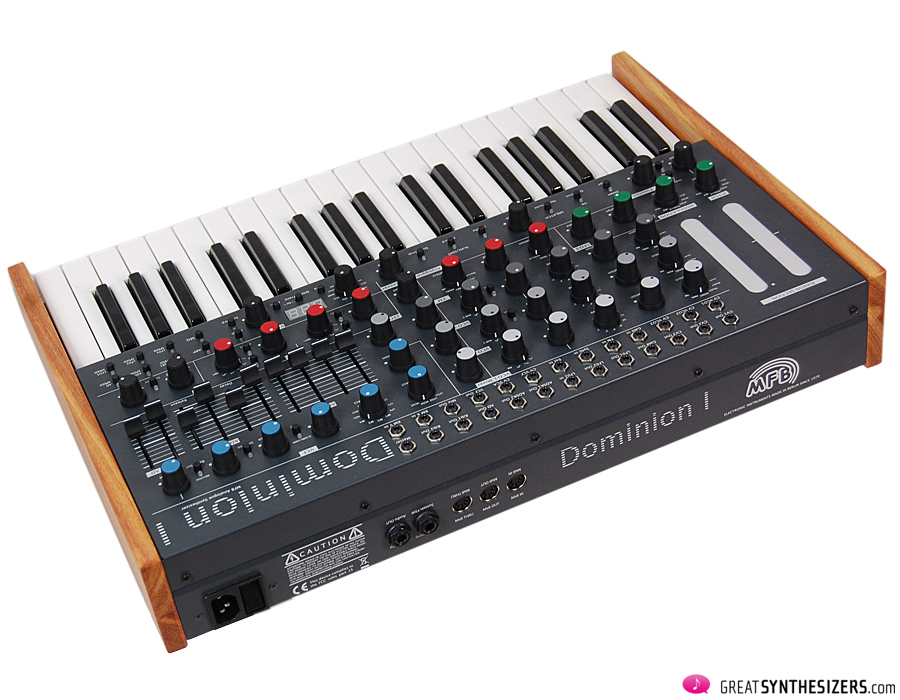

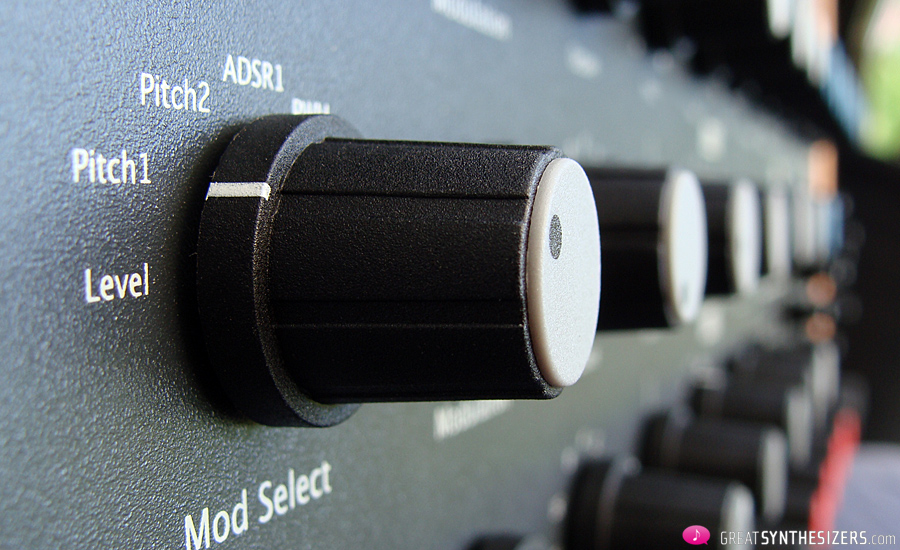
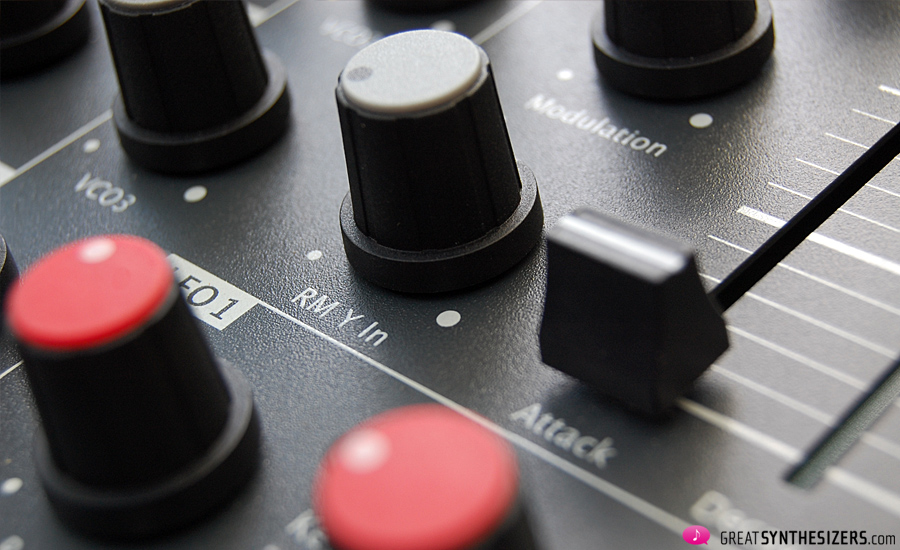
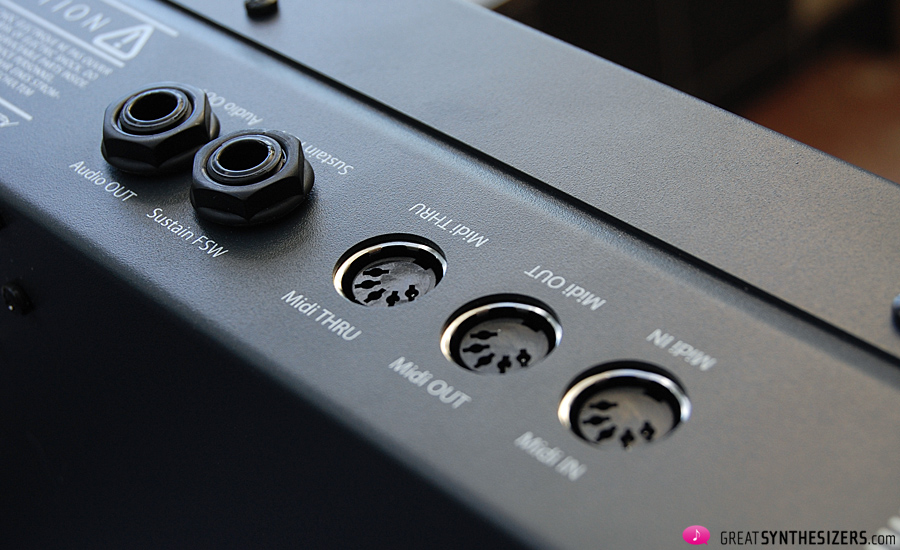
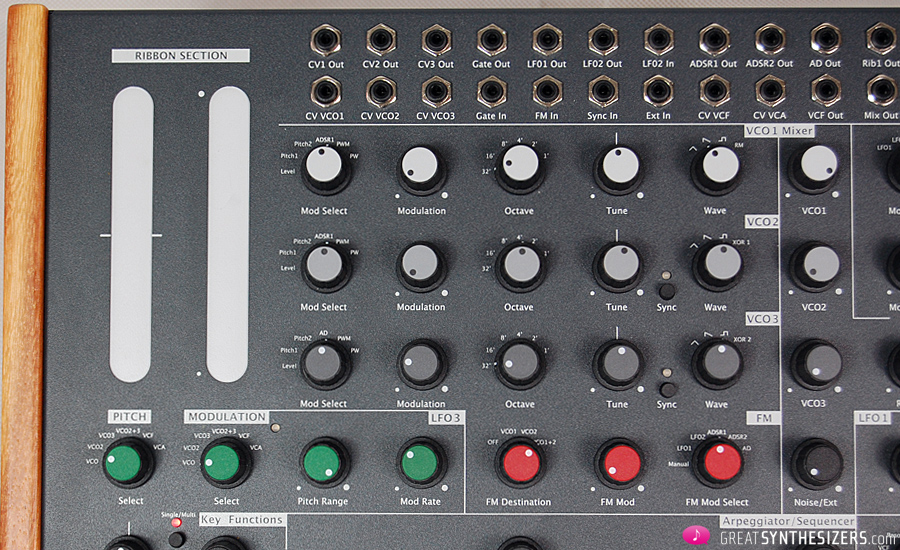

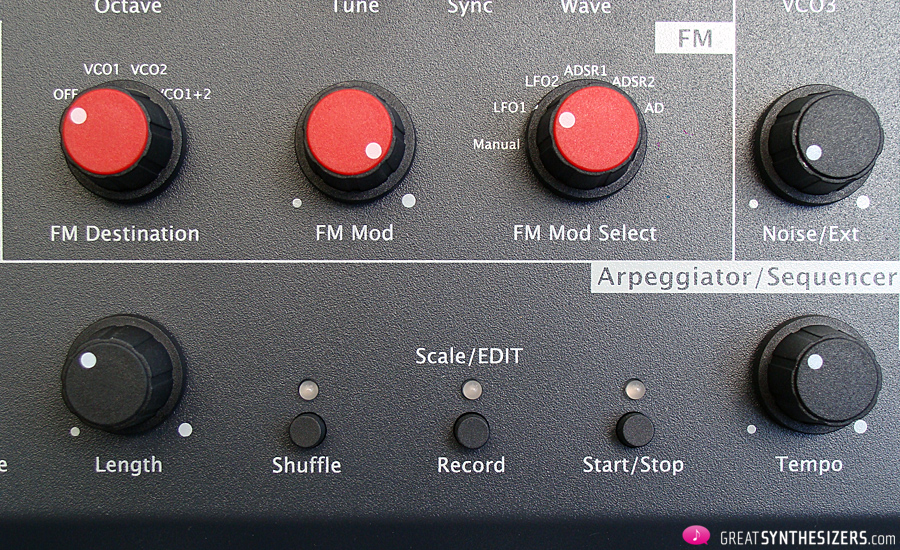



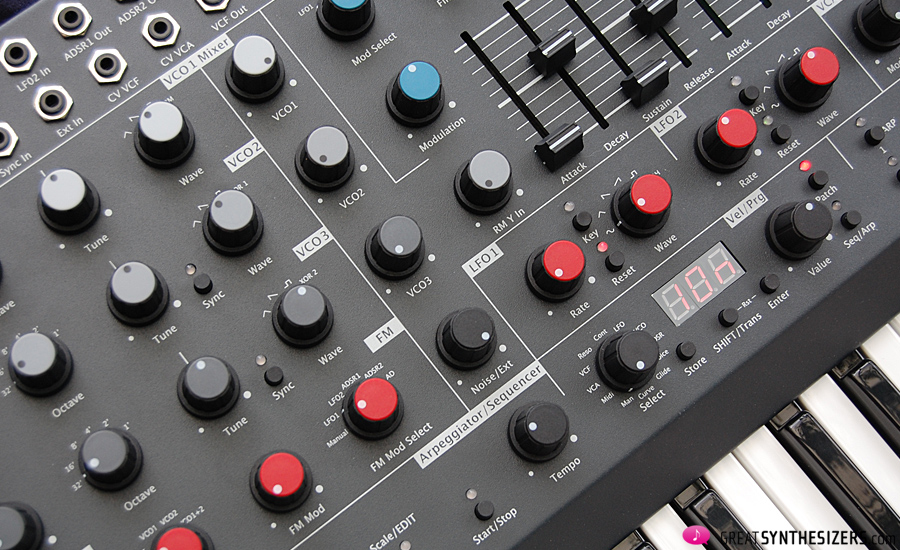
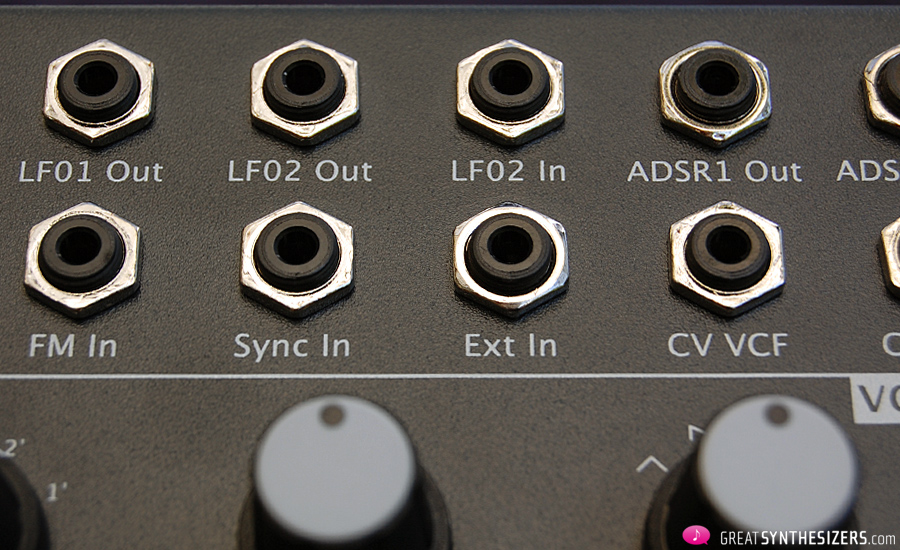

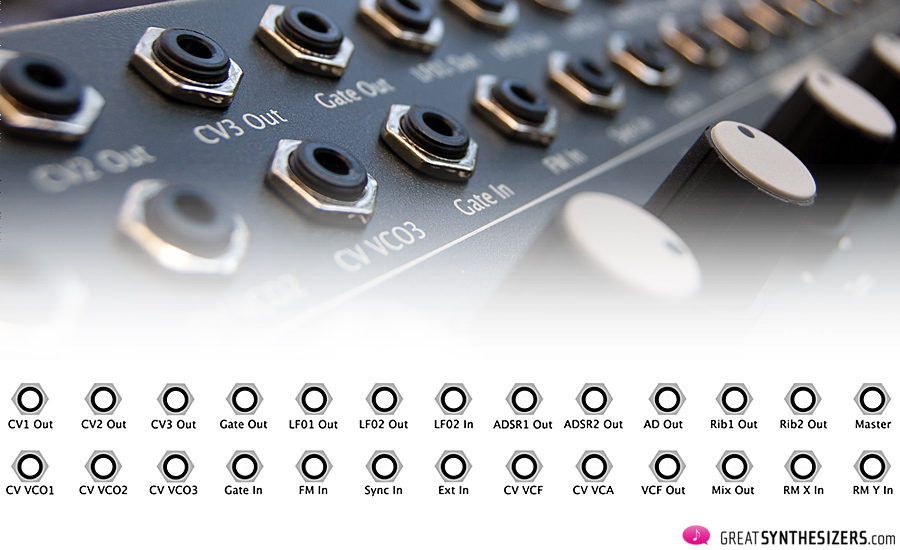
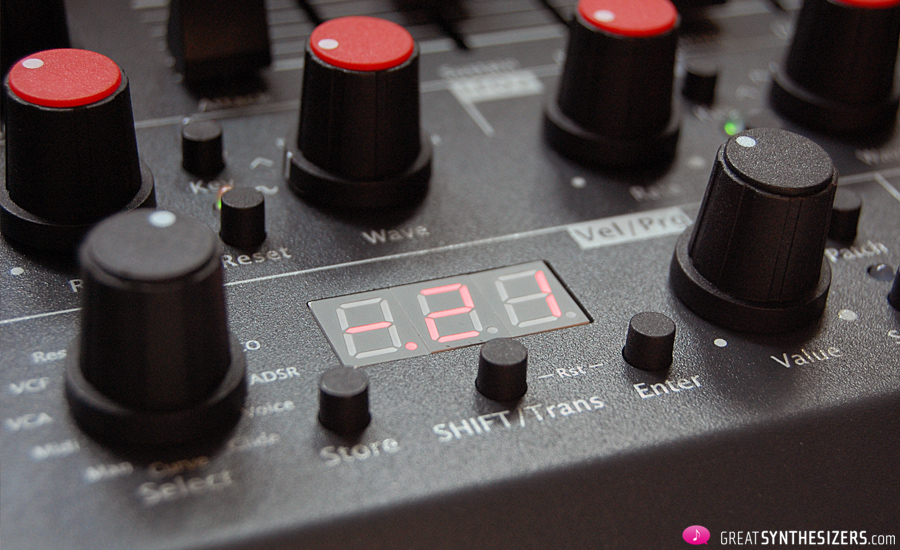
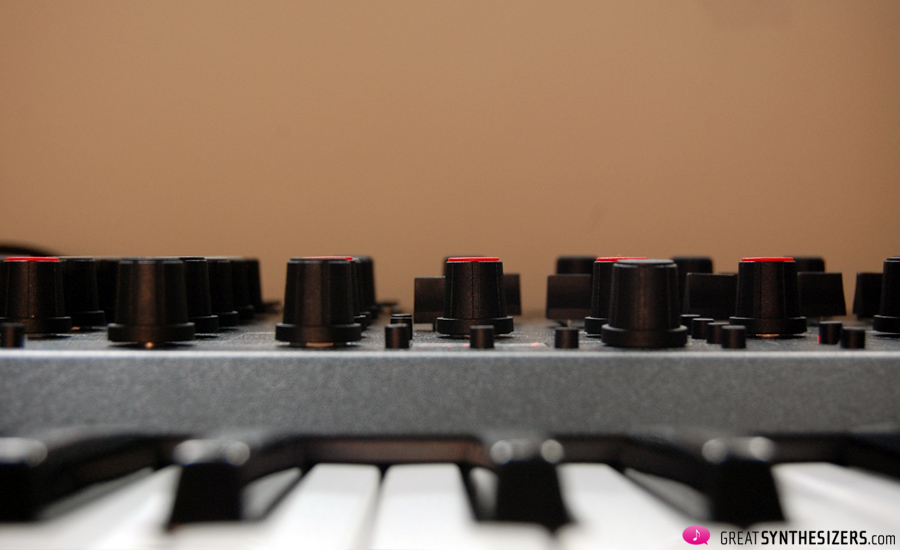

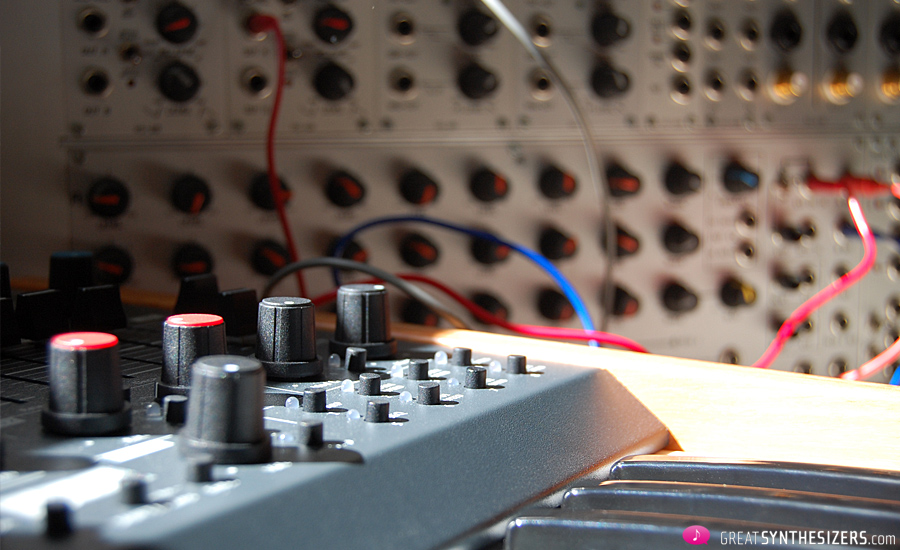
outstanding demo Theo ! ( as usual) , this thing sounds as great as any of the real classics, gnarly , fat , subtle …
Thanks (:o) The Dominion 1 “is” a classic. Compliment to MFB (and, I have to say, to Arturia – and some other companies – as well)!
Well, Theo, when is the revision coming and in what form? I would love to support MFB for their approach and especially if they have upped their build quality but when the hardware upgrade cat is out of the bag many people will wait out to see what improvements manufacturer can provide for their money.. so i guess the question is will we have to wait for the Dominion 1 MK II, will current users be able to upgrade and or are the units in manufacturing at the moment already being refitted with the new chip? Thanx for taking your time, cheers!
After consultation with MFB I must apologize for a misleading information. There will be new software chips, but in ‘future’ MFB products (not in the Dominion 1). A new chip would require a complete Dominion 1 redesign, which won’t happen. Still: from a musical point of view I fully recommend this instrument – it has an enormous amount of potential.
My Dominion 1 was shipped to me today by Thomann according to their email! I ordered it weeks ago and my excitement is almost too much! I look forward to much fun once it arrives.
Great news! Keep us posted …
My Dominion 1 arrived today:) Sounds so incredible. Not keen on the envelopes, clicky… The english manual i downloaded seems incomplete:) ….but hey.. beautiful anyway :)
I’ve only just discovered your amazing website. I shall be following you closely now.
This is the best review of the Dominion 1 on the internet. So many splendid demos (although I’d like to hear the dual-sync!)
Thank you, I’m very grateful!
Though I’m not a fan of their sound, to say the Prophet 12 / Pro 2 are “old classics in new cloths” or “new synths based on old concepts” is very, very inaccurate and very offending to the designers of those machines.
Thanks for the review nonetheless :)
Yes, I guess you’re right. The thoughts on DSI seemed a little patronizing – which shouldn’t happen. To be honest, it’s the marketing concept of some companies that bothers me. And to be more precise: I’m a little tired of all these glorious vintage names nowadays … Jupiter-50, Juno-D, Gaia SH-01, Prophet-08, Prophet-12, Pro-2 … some great concepts among these synths, but their sound and richness can not be compared to the real instruments back in the 70s and 80s. The Minimoog Voyager is at least a close replica of the original – so the name may be justified. Or take the NEW MS-20, alright … Anyway, I’ll make this point in the article more clear and precise.
This is by far the BEST Review about the Dominion 1 i’ve read so far – thx for that. I had the chance to check it out last week – and its true: “its sound is superb”. The Synth is a future classic IMO.
Thank you! Very impressed by the quality of both the review and demos.
Sold! Something is going on in every demo of this Dominion 1.. something that I have to verify personaly! (and i’m saying this after a synth-orgiac Namm2015).. or maybe it’s just the demos that correctly done here! :) cheers
Brilliant review, clarified so much and I am still enjoying the demos.
THANK YOU!
One question:
Is there any sort of filter bleeding on the LowPass? Or do they cut out like a knife through the high end?
:D
ordered mine a couple days ago. this review and amazing demos helped me make up my mind.
… great!
And how is it? I’m on a looooong waiting list
Also on a waiting list for the sub37, I’m of the mindset whichever lands first I will keep. I’m pretty scared to miss a classic which I believe both will be, they both offer insane value IMO. The main thing swaying me to the moog however is I know that it will still be there functioning properly in ten years, I worry about the mfb, that’s bad I know but as a family man these are the things to consider as this will likely be my last purchase for some many years due to new additions to the fold.
Hoping to hear lots of positives from owners soon.
I just got one of these and I’m using this review as a second manual, as it’s easier to understand. Thanks.
I’ve really been loving your reviews … thank you! Just curious on your impressions of the Dominion 1 vs. Perfourmer. I know they are apples and oranges when it comes to architecture – the Perfourmer being more like a poor man’s (relatively speaking) OB 4-voice. If you could only afford one which would you choose and why?
… it would depend on the setup I’d use …
Interacting with eurorack modulars and doing experimental stuff, I’d go for the Dominion 1 (which would serve as masterkeyboard, maybe even as a sort of control centre).
Doing synthesis in a rather traditional studio environment, I’d go for the Perfourmer MKII. Hardware is just completely professional and the sound is as perfect (analog) as it can be.
After hearing some demos of this synth I had to get one. I restore and use vintage moogs but I see this as a classic already and with all the interfacing capabilities, it will fit right in with my setup.
Hi I’ve ordered a dominion 1 from thomann. I was just wondering could you potentially fix the envelope problem buy using some kind of eurorack envelope generator? Can’t wait to get it. The shop says just over one month wait. hope this is acurate.
… of course. VCF and VCA have cv inputs, so it’s no problem using external envelopes for the signal path. In this case the internal envelopes can be all used for modulation stuff (LFO speed modulation, VCO pitch envelope, etc).
How can i get a dominion 1
… visit their homepage (see above) and order one :o)
Deluxe demos!!
You should put them together in a YouTube video with some cool background visuals…
And MFB should hire you as demonstrator and sound designer….
Hats off
… good idea :o)
Great demos. Great synth. I recently ordered one. The thing that absolutely closed the deal for me is this synths musicality! Its sounds cover the range of delicate resonances that are pleasant to listen to. I sat through the entire demo list. There was nothing harsh or annoyingly repetitive. I actually laughed in a couple places. Deluxe is a great description. I am thinking of using an H9 with it? It is really inspiring. squishy, wombly, spacey, bold, yet with a touch of whimsey (to steal a funny movie line). Like a great wine. perhaps a classic in the making.
… thumbs up !!!
No mention of portamento (glide). That is a must have feature for me!
Hello! Could you describe, please, how keyboard feels? Is it a good action keyboard, nice to play?
Thank you in advance!
Hi Theo,
Two awesome reviews (Dom1 and p4mer mk2). Really really thorough, more than most sites. Plus the awesome demos :)
I kind of have the same question someone asked before since I’m buying my first synth (experienced producer though). I’ve watched every single demo and read every review about the p4, and I love it. The sound, the concept.
And then I heard about the dom1, starting listening and reading and tjeez… I just cannot decide. If I had to go on raw sound alone, I’d choose the vermona, but when it comes to sound design possibilities? The dom1 seems pretty unbeatable. Here I was thinking the vermona could create crazy sounds…
Could you maybe give some more advice how to choose between these? i’ll eventually probably get them both haha (will take time). but what would be the better choice for a first synth?
Cheers
…. sorry, sorry – there IS glide, of course! 2nd black knob to the left of the keyboard.
Keyboard feels very smooth. Good quality, nice to play. (I’m “very” critical about keyboard actions – this is a good one.)
… for a first synth, I’d go for the Vermona. Simply because it has such a clear and logical layout. 4 synths in one, serial or parallel. Best analog sound ever! Not nearly as many modulation possibilities as the MFB, though, but still very interesting, versatile and with some “unique” extras (like the rotating voice system).
The Dominion 1 is more like a perfect addition to your Eurorack-system. Interact between the modules and your synth, experiment, get lost in a world full of modulation and sequencing / arpeggiating. A machine for the novice, though. Not a true first-time synth, I guess …
Thanks for the comment Theo, really appreciate it :).
I weighed all options and went with the Dominion. Also because it’s not really my true first synth in that I use a lot of software synths (I forgot the word ‘hardware’ at the end of my last post I see now). So I was thinking maybe going the Expert-Sleepers (silentway) route at some point, or some external gear. Was looking at the Effectivy Spring Reverb for instance.
The many modulation possibilities on the d1 iself seem already like a candy store to me either way :)
Maybe I’ll get the vermona at some point too. It seems like an amazing synth as well. Thanks again for the great amounts of info and insight. Cheers!
Thank you for this test, very helpful!
Good day!
Theo, could you help me with another question? When one plays polyphonically, how are VCOs distributed between simultaneous voices? There is a note in the manual, which states that:
“In paraphonic mode, all three VCOs work in unison
as long only one note is being played. For each
additional note played, an oscillator is being subtracted
from the unison sound”
But it is not very clear to me. When I play second note, what VCO gets subtracted? Am I correct thinking that when I play a chord, all three VCOs are used, and my three notes (VCOs) may sound differently, if I chose different waveforms, pitches, modulations for each VCO?
And another question would be about sequencer. We should push SHIFT button and a new key in order to transpose sequence. Does it mean that If I programme my sequence “third-third-fifth” and originally start it on C, so when I transpose it and push D#, my sequence will be run from D# and with respective intervals?
And can I run a monophonic sequence and at the same time play a melody in para-mode?
I am sorry if I expressed my thought a bit awkwardly, because of my English. But thank you for your help!
But it is not very clear to me. When I play second note, what VCO gets subtracted? Am I correct thinking that when I play a chord, all three VCOs are used, and my three notes (VCOs) may sound differently, if I chose different waveforms, pitches, modulations for each VCO?
>>> “Yes, that’s not clear how it works. What I discovered: ONE note means all 3 VCOs unison, TWO note means VCO3 in the lower and VCO1/2 in the higher note (interesting), THREE notes use the VCOs in their regular order: lowest note VCO1, middle note VCO2, highest note VCO3 – with all their individual octave settings, waveforms, etc. So you can invert harmonies by setting VCO1 to 4′, VCO2 to 16′ and VCO3 to 32′, which means that the highest of the 3 notes played has the lowest frequency.”
And another question would be about sequencer. We should push SHIFT button and a new key in order to transpose sequence. Does it mean that If I programme my sequence “third-third-fifth” and originally start it on C, so when I transpose it and push D#, my sequence will be run from D# and with respective intervals?
>>> “Exactly … (you have to push SHIFT + D# simultaneously).”
And can I run a monophonic sequence and at the same time play a melody in para-mode?
>>> “No, this is why it’s paraphonic (and not polyphonic). The Dominion 1 can’t generate 2 independent voices (e.g. sequencer pattern + solo line above). What you CAN do is recording 1, 2 or 3 notes at the same time when recording a sequence (simply hit 3 keys – a harmony – at once, this will count as “one” step). All 3 notes have the same length, sharing one filter, this is how it works – paraphonic.”
I am sorry if I expressed my thought a bit awkwardly, because of my English. But thanks you for your help!
>>> “No problem. Hope you enjoy the Dominion 1 …”
Appreciate your help! Thank you again! I want to buy one, and those questions were sort of critical to me. Hopefully, other musicians will find a lot of usefull information here.
Hi Theo,
Thanks again for this review. I’ve had the Dominion1 for over a month now, and man, this beast is ever bit as good as you said it would be. Sounddesign heaven. Since I produce pretty rough techno most of the time, buying this wonderful machine was one of the best choices I’ve ever made. Can’t wait to start gigging with it.
And now…. Now I really want a tanzmaus :P
Love these sounds !!!
Hi. Thanks for this. Great review. I recently bought one and loved it. There is one thing I’m trying to figure out. The FM synthesis seems to work differently on oscillator 1 than it does on oscillator 2. I had expected it to be the same. 2 seems more aggressive even though the settings for oscillators 1 and 2 are exactly the same. The manual doesn’t build an expectation of difference. Did you notice the same thing? Any idea what’s going on? Thanks a million.
Very nice review and demos. I am one of the few and fortunate people in the U.S. who owns one. This synth is incredible and so much fun to work with. It’s incredibly inspiring, sounds amazing, and just invites you to get hands on. I also own an Oberheim Two Voice Pro and both synths are great and compliment each other well. The Dominion1 has more bite in my opinion.
Hi
I bought the D1 about 1 month ago, I am trying
everyday, but I can not get sounds like Theo
share here, i think that would be interesting for everyone
like me that is a little lost with this synth,
I would like to know f is possible to speak
a little about a couple patch I heard here,
one is the SEQU 2, another thing is that
It`s a deluxe synth, but there isn`t a deluxe manual
or a deluxe easy manual, to get the best out
of the synth, the sound is fantastic but I am having
troubles to tame it, go harsh territory very easy,
maybe is like andromeda and we should be careful
with vca and vco amounts, don`t know but I can not get
the sounds like on the demos above, that`s for sure,
I have experienced with oberheim sem and another
simple analogs, but this is much more complicated,
I turn knobs but get always harsh and I don`t like
the sound I get out of it, so think that here people can share
tips here.
Thank you in advance for any help
Cheers
Hi
I found a good video where explain a
little about how works the D1, I leave the name
if anybody interested, is MFB Dominion 1 review
Right now I am doing an arp random sound with fm
on the LFO that never thought that the dominion can produce, awesome, mod selection in LFO too, range A3
and make like a repeat loop similar to granular
but more natural, mod select pitch in all osc
resonance, fm destination VCO1, very dreamy
with mix of past and future I think,
You mentioned the ADSRs are software based. Is this similar to the DSI envelop sound? I owned a mopho X4 and found something strange about the VCA/envelops that I couldn’t put my finger on.
To specify: How does the software based ENV effect the sound. Does it effect the tone of the VCA like a DSI, or is it purely it the shape of the modulation to the VCA? Does it cause any zippering sounds with a very quick ramp setting on the attack? How’s the key click?
Theo,
All tracks sound GR8! I know the D-1 isn’t polyphonic but I’m hearing so much going on … is there multirtracking in the examples? Could you please specify which examples are played through in one pass, so to speak. Lastly, as I understand paraphonic, three notes, as in a chord, are possible at a time? But three polyphonic lines aren’t possible? Am a I hearing what sounds like more than one line at a time because there’s so much going on in the D-1 sound?
Thanks in advance … your examples are all GORGEOUS!!!
… hi Mark!
You’re right, that’s not really clear at all. Well, usually it’s multitrack recording, e.g. Soft Solo (solo means it’s the Dominion 1 “only”, no other synths involved). I guess I never used the paraphonic mode in any way, since multitrack recording opens all those great musical possibilities (while paraphonic mode limits you to a strange mixture of sonic polyphony combined with monophony in terms of rhythmical variation). So, no paraphonic sounds. There “are” some true solo lines (e.g. VCO Mod By ADSR1), but usually it’s between 2 and 5 Dominion 1 tracks mixed together … The point is, that it’s all the MFB, which means the Dominion 1 is able to fullfill most (if not all) musical needs* in your studio. The MIX soundfiles contain different synths, though (e.g. MIX1 > that strong solo-sound with stereo-panning is a GRP A8). More details to be found in the Listening Room :o)
Regards, Theo
* (in terms of analog sounds)
Great article and clips, have just ordered a D1 … do you know if anything other than note value can be addressed via Midi or the internal sequencer?
Thanks,
Rich